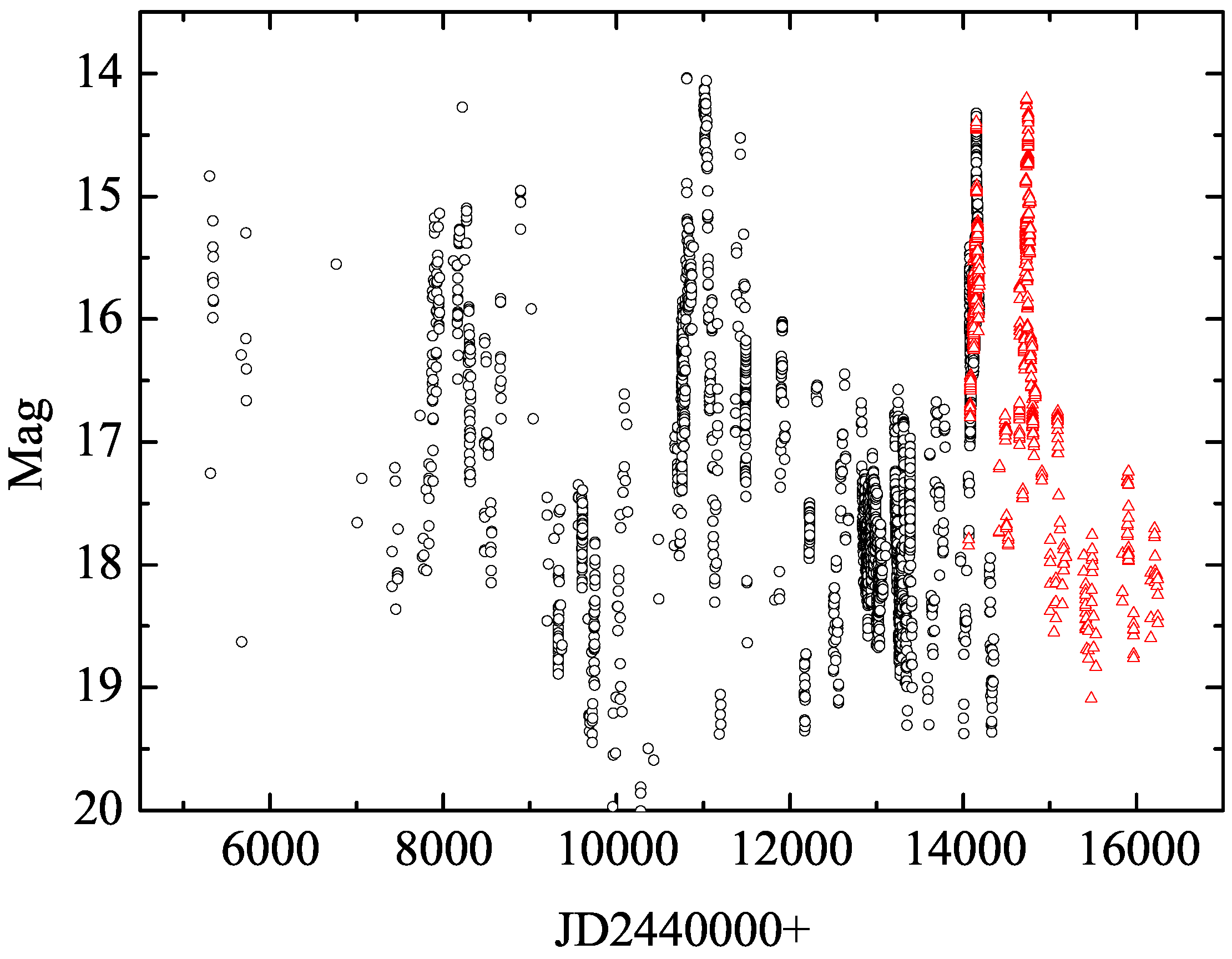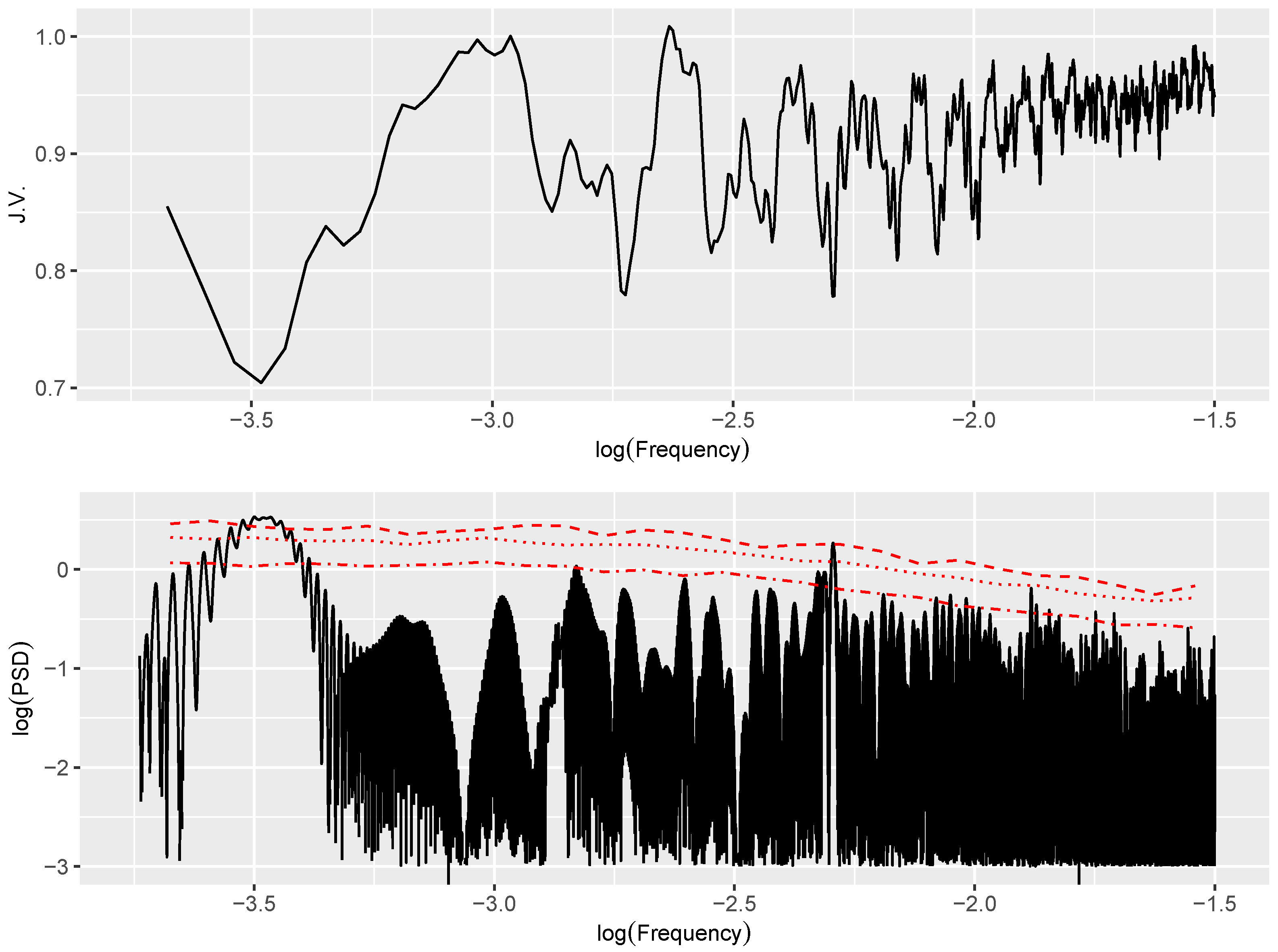The Optical Variability of the BL Lac AO 0235+164
Abstract
:1. Introduction
2. Observations
Period Analysis
3. Discussions and Conclusions
4. Summary
- (1)
- The largest variation = 4.88 mag is detected from our observations.
- (2)
- There are two periods in the light curve, = 8.26 yr and = 0.54 yr.
Acknowledgments
Author Contributions
Conflicts of Interest
References
- Padovani, P.; Giommi, P. The connection between X-ray- and radio-selected BL Lacertae objects. Astrophys. J. 1995, 444, 567–581. [Google Scholar] [CrossRef]
- Urry, C.M.; Padovani, P. Unified Schemes for Radio-Loud Active Galactic Nuclei. Publ. Astron. Soc. Pac. 1995, 107, 803–845. [Google Scholar] [CrossRef]
- Abdo, A.A.; Ackermann, M.; Agudo, I.; Axelsson, M.; Baldini, L.; Ballet, J.; Barbiellini, G.; Bastieri, D.; Baughman, B.M.; Bechtol, K.; et al. The Spectral Energy Distribution of Fermi Bright Blazars. Astrophys. J. 2010, 716, 30–70. [Google Scholar] [CrossRef]
- Fan, J.H.; Yang, J.H.; Liu, Y.; Luo, G.Y.; Lin, C.; Yuan, Y.H.; Xiao, H.B.; Zhou, A.Y.; Hua, T.X.; Pei, Z.Y. The Spectral Energy Distributions of Fermi Blazars. Astrophys. J. Suppl. Ser. 2016, in press. [Google Scholar]
- Fan, J.H. Optical Variability of Blazars. Chin. J. Astron. Astrophys. 2005, 5, 213–223. [Google Scholar] [CrossRef]
- Jurkevich, I. A Method of Computing Periods of Cyclic Phenomena. Astrophys. Space Sci. 1971, 13, 154–167. [Google Scholar] [CrossRef]
- Sillanpää, A.; Haarala, S.; Valtonen, M.J.; Sundelius, B.; Byrd, G.G. OJ 287—Binary pair of supermassive black holes. Astrophys. J. 1988, 325, 628–634. [Google Scholar] [CrossRef]
- Fan, J.H.; Xie, G.Z.; Pecontal, E.; Pecontal, A.; Copin, Y. Historic Light Curve and Long-Term Optical Variation of BL Lacertae 2200+420. Astrophys. J. 1998, 507, 173–178. [Google Scholar] [CrossRef]
- Fan, J.H.; Lin, R.G.; Xie, G.Z.; Zhang, L.; Mei, D.C.; Su, C.Y.; Peng, Z.M. Optical periodicity analysis for radio selected BL Lacertae objects (RBLs). Astron. Astrophys. 2002, 381, 1–5. [Google Scholar] [CrossRef]
- Ciaramella, A.; Bongardo, C.; Aller, H.D.; Aller, M.F.; De Zotti, G.; Lähteenmaki, A.; Longo, G.; Milano, L.; Tagliaferri, R.; Teräsranta, H.; et al. A multifrequency analysis of radio variability of blazars. Astron. Astrophys. 2004, 419, 485–500. [Google Scholar] [CrossRef]
- Wu, J.H.; Zhou, X.; Wu, X.B.; Liu, F.K.; Peng, B.; Ma, J.; Wu, Z.; Jiang, Z.J.; Chen, J.S. Optical Monitoring of BL Lacertae Object OJ 287: A 40 Day Period? Astron. J. 2006, 132, 1256–1266. [Google Scholar] [CrossRef]
- Ciprini, S.; Takalo, L.O.; Tosti, G. Ten-year optical monitoring of PKS 0735+178: Historical comparison, multiband behavior, and variability timescales. Astron. Astrophys. 2007, 467, 465–483. [Google Scholar] [CrossRef]
- Fan, J.H.; Liu, Y.; Hua, T.X.; Wang, H.G.; Wang, Y.X.; Yang, J.H.; Gupta, A.C.; Li, J.; Zhou, J.L.; Xu, S.X.; et al. Radio variability properties for radio sources. Astron. Astrophys. 2007, 462, 547–552. [Google Scholar] [CrossRef]
- Valtonen, M.; Kidger, M.; Lehto, H.; Poyner, G. The structure of the October/November 2005 outburst in OJ287 and the precessing binary black hole model. Astron. Astrophys. 2008, 477, 407–412. [Google Scholar] [CrossRef]
- Rani, B.; Gupta, A.C.; Joshi, U.C.; Ganesh, S.; Wiita, P.J. Quasi-periodic Oscillations of 15 Minutes in the Optical Light Curve of the BL Lac S5 0716+714. Astrophys. J. 2010, 719, L153–L157. [Google Scholar] [CrossRef]
- Qian, B.C.; Tao, J. Optical Monitoring of PKS 0735+178 from 1995 to 2001 and Its Historical Periodic Light Curve. Publ. Astron. Soc. Pac. 2004, 116, 161–169. [Google Scholar] [CrossRef]
- Gupta, A.C. Quasi Periodic Oscillations in Blazars. J. Astrophys. Astron. 2014, 35, 307–314. [Google Scholar] [CrossRef]
- Webb, J.R.; Howard, E.; Bentez, E.; Balonek, T.; McGrath, E.; Shrader, C.; Robson, I.; Jenkins, P. The 1997 Outburst of AO 0235+164: Evidence for a Microlensing Event? Astron. J. 2000, 120, 41–46. [Google Scholar] [CrossRef]
- Romero, G.E.; Combi, J.A.; Benaglia, P.; Azcarate, I.N.; Cersosimo, J.C.; Wilkes, L.M. Search for intraday radio variability in EGRET blazars. Astron. Astrophys. 1997, 326, 77–86. [Google Scholar]
- Romero, G.E.; Cellone, S.A.; Combi, J.A. Extreme intranight variability in the BL Lacertae object AO 0235+164. Astron. Astrophys. 2000, 360L, 47–50. [Google Scholar]
- Peng, B.; de Bruyn, A.G. Evidence for Microarcsecond Structure in the BL Lacertae Object AO 0235+164. Astrophys. J. 2004, 610, 151–155. [Google Scholar] [CrossRef]
- Hagen-Thorn, V.A.; Larionov, V.M.; Jorstad, S.G.; Arkharov, A.A.; Hagen-Thorn, E.A.; Efimova, N.V.; Larionova, L.V.; Marscher, A.P. The Outburst of the Blazar AO 0235+164 in 2006 December: Shock-in-Jet Interpretation. Astrophys. J. 2008, 672, 40–47. [Google Scholar] [CrossRef]
- Ackermann, M.; Ajello, M.; Ballet, J.; Barbiellini, G.; Bastieri, D.; Bellazzini, R.; Blandford, R.D.; Bloom, E.D.; Bonamente, E.; Borgland, A.W.; et al. Multi-wavelength Observations of Blazar AO 0235+164 in the 2008–2009 Flaring State. Astrophys. J. 2012, 751, 159–178. [Google Scholar] [CrossRef]
- Wang, H.T. The optical periodic analysis of BL Lac object AO 0235+164. Astrophys. Space Sci. 2014, 351, 281–287. [Google Scholar] [CrossRef]
- Vol’vach, A.E.; Larionov, M.G.; Vol’vach, L.N.; Lähteenmäki, A.; Tornikoski, M.; Aller, M.F.; Aller, H.D.; Sasada, M. Physical characteristics of the Blazar AO 0235+164. Astron. Rep. 2015, 59, 145–155. [Google Scholar] [CrossRef]
- Fan, J.H.; Lin, R.G. Optical Variability and Periodicity Analysis for Blazars. I. Light Curves for Radio-selected BL Lacertae Objects. Astrophys. J. 2000, 537, 101–122. [Google Scholar] [CrossRef]
- Raiteri, C.M.; Villata, M.; Aller, H.D.; Aller, M.F.; Heidt, J.; Kurtanidze, O.M.; Lanteri, L.; Maesano, M.; Massaro, E.; Montagni, F.; et al. Optical and radio variability of the BL Lacertae object AO 0235+16: A possible 5–6 year periodicity. Astron. Astrophys. 2001, 377, 396–412. [Google Scholar] [CrossRef]
- Romero, G.E.; Fan, J.H.; Nuza, S.E. The Binary Black Hole Scenario for the BL Lacertae Object AO 0235+16. Chin. J. Astron. Astrophys. 2003, 3, 513–525. [Google Scholar] [CrossRef]
- Ostorero, L.; Villata, M.; Raiteri, C.M. Helical jets in blazars. Interpretation of the multifrequency long-term variability of AO 0235+16. Astron. Astrophys. 2004, 419, 913–925. [Google Scholar] [CrossRef]
- Kurtanidze, O.; Nikolashvili, M.; Kimeridze, G.N.; Sigua, L.A.; Kapanadze, B.Z.; Ivanidze, R.Z. Long-term photometry of blazars at Abastumani Observatory. In Proceedings of IAU Symposium 238, Prague, Czech Republic, 21–25 August 2006; Cambridge University Press: Cambridge, UK, 2007; pp. 397–398. [Google Scholar]
- Nikolashvili, M.; Kurtanidze, O. Long-term and intra-day variability of BL Lacertae since the last great outburst. Proc. Int. Astron. Union 2007, 238, 419–420. [Google Scholar] [CrossRef]
- Fan, J.H.; Kurtanidze, O.; Nikolashvili, M.G.; Gupta, A.C.; Zhang, J.S.; Yuan, Y.H. Optical Photometric Observations of γ-Ray Loud Blazars. Chin. J. Astron. Astrophys. 2004, 4, 133–142. [Google Scholar] [CrossRef]
- Fan, J.H.; Kurtanidze, O.; Liu, Y.; Richter, G.M.; Chanishvili, R.; Yuan, Y.H. Optical Monitoring of Two Brightest Nearby Quasars, PHL 1811 and 3C 273. Astrophys. J. Suppl. Ser. 2014, 213, 26–37. [Google Scholar] [CrossRef]
- Fan, J.H.; Kurtanidze, O.; Liu, Y.; Liu, X.; Yang, J.H.; Richter, G.M.; Nikolashvili, M.G.; Kurtanidze, S.O.; Wang, H.T.; Sasada, M.; et al. The Variability and Period Analysis for the BL Lac AO 0235+164. Astrophys. J. 2016. submitted. [Google Scholar]
- Liu, Y.; Fan, J.H.; Wang, H.G.; Deng, G.G. Methods for the Quasi-Periodic Variability Analysis in Blazars. J. Astrophys. Astron. 2011, 32, 79–86. [Google Scholar] [CrossRef]
- Ferraz-Mello, S. Estimation of Periods from Unequally Spaced Observations. Astron. J. 1981, 86, 619–624. [Google Scholar] [CrossRef]
- Foster, G. The cleanest Fourier spectrum. Astron. J. 1995, 109, 1889–1902. [Google Scholar] [CrossRef]
- Mudelsee, M. TAUEST: A computer program for estimating persistence in unevenly spaced weather/climate time series. Comput. Geosci. 2002, 28, 69–72. [Google Scholar] [CrossRef]
- Romero, G.E.; Cellone, S.A.; Combi, J.A. Optical microvariability of southern AGNs. Astron. Astrophys. Suppl. Ser. 1999, 135, 477–486. [Google Scholar] [CrossRef]
- Heidt, J.; Wagner, S.J. Statistics of optical intraday variability in a complete sample of radio-selected BL Lacertae objects. Astron. Astrophys. 1996, 305, 42–52. [Google Scholar]
- Fan, J.H.; Peng, Q.S.; Tao, J.; Qian, B.C.; Shen, Z.Q. Optical Observations of 3C 273 From 2000 to 2008. Astron. J. 2009, 138, 1428–1434. [Google Scholar] [CrossRef]
- Schramm, K.-J.; Bogeest, U.; Kuhl, D.; von Linde, J.; Linnert, M.D.; Schramm, T. The Hamburg quasar monitoring program (HQM) at Calar Alto. III. Lightcurves of optically violent variable sources. Astron. Astrophys. Suppl. Ser. 1994, 106, 349–359. [Google Scholar]
- Urry, C.M.; Sambruna, R.M.; Worral, D.M.; Kollgaard, R.I.; Feigelson, E.D.; Perlman, E.S.; Stocke, J.T. Soft X-Ray Properties of a Complete Sample of Radio-selected BL Lacertae Objects. Astrophys. J. 1996, 463, 424–443. [Google Scholar] [CrossRef]
- Rieke, G.H.; Grasdalen, G.L.; Kinman, T.D.; Hintzen, P.; Wills, B.J.; Wills, D. Photometric and spectroscopic observations of the BL Lacertae object AO 0235+164. Nature 1976, 260, 754–759. [Google Scholar] [CrossRef]
- Stein, W.A.; Odell, S.L.; Strittmatter, P.A. The BL Lacertae objects. Annu. Rev. Astron. Astrophys. 1976, 14, 173–195. [Google Scholar] [CrossRef]
- Webb, J.R.; Smith, A.G.; Leacock, R.J.; Fitzgibbons, G.L.; Gombola, P.P.; Shepherd, D.W. Optical observations of 22 violently variable extragalactic sources—1968–1986. Astron. J. 1988, 95, 374–397. [Google Scholar] [CrossRef]
- Smith, A.G.; Nair, A.D. Timescales of Long-Term Optical Base-Level Fluctuations in Three Classes of AGN. Publ. Astron. Soc. Pac. 1995, 107, 863–870. [Google Scholar] [CrossRef]
- Raiteri, C.M.; Villata, M.; Kadler, M.; Ibrahimov, M.A.; Kurtanidze, O.M.; Larionov, V.M.; Tornikoski, M.; Boltwood, P.; Lee, C.-U.; Aller, M.F.; et al. Multifrequency variability of the blazar AO 0235+164. The WEBT campaign in 2004–2005 and long-term SED analysis. Astron. Astrophys. 2006, 459, 731–743. [Google Scholar] [CrossRef]
- Raiteri, C.M.; Villata, M.; Capetti, A.; Heidt, J.; Arnaboldi, M.; Magazzù, A. Spectroscopic monitoring of the BL Lac object AO 0235+164. Astron. Astrophys. 2007, 464, 871–878. [Google Scholar] [CrossRef]
- Raiteri, C.M.; Villata, M.; Larionov, V.M.; Aller, M.F.; Bach, U.; Gurwell, M.; Kurtanidze, O.M.; Lähteenmäki, A.; Nilsson, K.; Volvach, A.; et al. Radio-to-UV monitoring of AO 0235+164 by the WEBT and Swift during the 2006–2007 outburst. Astron. Astrophys. 2008, 480, 339–347. [Google Scholar] [CrossRef]
- Gupta, A.C.; Cha, S.-M.; Lee, S.; Jin, H.; Pak, S.; Cho, S.; Moon, B.; Park, Y.; Yuk, I.-S.; Nam, U.; et al. Multicolor Near-Infrared Intra-Day and Short-Term Variability of the Blazar S5 0716+714. Astron. J. 2008, 136, 2359–2366. [Google Scholar] [CrossRef]


© 2016 by the authors; licensee MDPI, Basel, Switzerland. This article is an open access article distributed under the terms and conditions of the Creative Commons Attribution (CC-BY) license (http://creativecommons.org/licenses/by/4.0/).
Share and Cite
Fan, J.; Kurtanidze, O.; Liu, Y.; Liu, X.; Richter, G.M.; Nikolashvili, M.G.; Kurtanidze, S.O.; Chanishvili, R.; Wang, H.; Sasada, M.; et al. The Optical Variability of the BL Lac AO 0235+164. Galaxies 2016, 4, 17. https://doi.org/10.3390/galaxies4030017
Fan J, Kurtanidze O, Liu Y, Liu X, Richter GM, Nikolashvili MG, Kurtanidze SO, Chanishvili R, Wang H, Sasada M, et al. The Optical Variability of the BL Lac AO 0235+164. Galaxies. 2016; 4(3):17. https://doi.org/10.3390/galaxies4030017
Chicago/Turabian StyleFan, Junhui, Omar Kurtanidze, Yi Liu, Xiang Liu, Gotthard M. Richter, Maria G. Nikolashvili, Sophia O. Kurtanidze, Revaz Chanishvili, Hongtao Wang, Mahito Sasada, and et al. 2016. "The Optical Variability of the BL Lac AO 0235+164" Galaxies 4, no. 3: 17. https://doi.org/10.3390/galaxies4030017
APA StyleFan, J., Kurtanidze, O., Liu, Y., Liu, X., Richter, G. M., Nikolashvili, M. G., Kurtanidze, S. O., Chanishvili, R., Wang, H., Sasada, M., Zhou, A., Lin, C., & Yuan, Y. (2016). The Optical Variability of the BL Lac AO 0235+164. Galaxies, 4(3), 17. https://doi.org/10.3390/galaxies4030017







